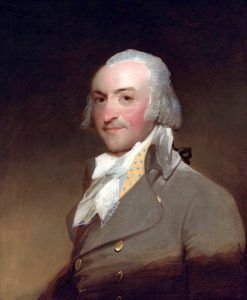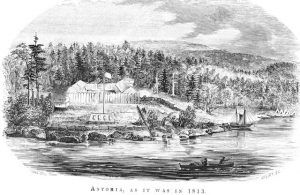The Pacific Fur Company was an American fur trade company that operated from 1810 to 1813 in the Pacific Northwest,
Founded in June 1810 by John Jacob Astor, half of the stock was held by the American Fur Company, owned exclusively by Astor. The other half was owned by working partners. A year after its founding, the company established Fort Astoria in Oregon. Astor planned the post to grow into a permanent settlement, with plans to develop a large trade ring that included New York, the Pacific Coast, Russian Alaska, Hawaii, and China. The furs collected in the northwest and Alaska would be shipped to China and exchanged for porcelain, silk, and other cloth, and spices that would be brought back, via Hawaii to New York.
The first sea expedition on the Tonquin left New York in September 1810, stopped at Hawaii where a number of Native Hawaiian laborers were picked up, and arrived at the Columbia River in April 1811, where Fort Astoria was established. The ship then sailed up the Pacific Coast to trade but was taken over by the Tlaoquiaht tribe of Clayoquot Sound, Vancouver Island. The warriors killed 61 men before the ship was blown up by a surviving crew member.
About the same time the first sea expedition started, Astor also mounted an overland expedition in 1810-12. Called the Astor Expedition, it was led by Wilson Price Hunt and was the first overland expedition from St. Louis, Missouri to the mouth of the Columbia River after the Corps of Discovery, led by Lewis and Clark.
The party ascended the Missouri River as far as the Arikara villages near present-day Mobridge, South Dakota, then went west overland. Along the way, the expedition discovered South Pass, Wyoming, through which hundreds of thousands of settlers would later travel theOregon, California, and Mormon Trails through the Rocky Mountains. When they continued on to the Snake River in southern Idaho. They abandoned their horses at Fort Henry and built canoes, but had to abandon this idea when they encountered a number of rapids. After two men and many of their food and supplies were lost, they divided into three main groups, each making their way to the Columbia River. Most of them arrived at Fort Astoria in the early part of 1812.
That year, the company suffered several setbacks, the first of which was the supply ship Beaver being late to arrive. The loss of the Tonquin vessel had left the post vulnerable at Fort Astoria found itself at risk of being captured by the British during the War of 1812. The following year, Fort Astoria and all other assets in the area were sold to the North West Company.
By Kathy Weiser-Alexander, updated May 2021.
Also See:
The Great Fur Trading Companies


